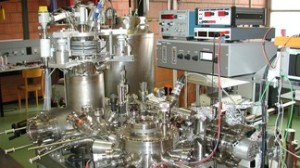Nov 30 2013
Scientists at EPFL have used scanning tunneling microscopy to detect rotational states of molecules for the first time.
 © 2013 EPFL
© 2013 EPFL
Molecules are not static; instead they are characterized by the constant vibration of the atoms that make them up, as well as by permanent rotations of the entire molecule. Each of these two motions confers to the molecule an inherent excitation energy, and this energy can then be used as a unique identifier for an unknown molecule. Although vibration modes have been successfully observed for individual molecules, their rotational aspects have been more elusive. In a breakthrough Physical Review Letters publication, EPFL scientists have used scanning tunneling microscopy to observe rotational levels of different hydrogen isotopes.
An ongoing pursuit in fundamental physics is the understanding of how matter behaves down to the microscopic level. The individual dynamics of atoms and molecules lie at the heart of material properties, and fully understanding them is critical for the future of chemical and physical technologies. However, studying individual molecules, or even a single layer of molecules, can be very difficult, as the readout signals can be too weak to detect or the molecules can simply be blown away.
One technique that has proven very successful in this process is the scanning tunneling microscope (STM). The STM is a type of electron microscope that can create 3D images of a sample by exploiting the ability of electrons to “tunnel” through an energy barrier (in this case, a vacuum). The STM consists of a very sharp metal tip that is brought only few atoms away from the sample surface. When a voltage is applied between the tip and the sample, electrons can tunnel across the vacuum barrier between them. The distance between tip and sample is constantly adjusted in order to keep the tunneling current constant. The STM tip scans laterally across the sample’s surface, generating a 3D image that reveals topographic and structural information of the sample.
The main characteristic of a molecule is its energy level. This is the product of its electronic structure, as well as the movement of atoms within the molecule. Atoms generally move in two ways: they vibrate and they rotate. Determining the energy from each of these two types of movement, it is possible to gain tremendous insights into the type and behavior of a particular molecule. But although vibration has been successfully observed in the past, the observation of rotational motion has proven to be a much greater challenge.
Using STM, a team led by Harald Brune has succeeded in observing rotational states in hydrogen isotopes. The researchers studied monolayers of molecular hydrogen and its isotopes hydrogen-deuterium and deuterium attached to a hexagonal boron nitride surface. As the STM tip probed the hydrogen monolayers, the scientists observed sharp changes in the electrical conductance that corresponded to very characteristic rotational energy levels. For certain molecules, rotational levels and the molecular nuclear spin states are strictly correlated. For example, hydrogen exists in two different forms depending on whether its two nuclei show parallel (“ortho”) or antiparallel (“para”) spins. Using their STM approach to observe rotational states, the EPFL team was also able to identify spin isomers of molecular hydrogen.
The authors believe that their STM method for identifying rotational states of molecules can be extended to molecules with more than two atoms like methane and ammonia, ultimately being used to determine the nuclear spin states of such molecules and study nuclear processes with unprecedented spatial resolution, which can be used in the study of chemical, electronic, magnetic, mechanic and nuclear properties and behaviors of a wide range of materials.
Reference
Natterer FD, Patthey F, Brune H. 2013. Distinction of Nuclear Spin States with the Scanning Tunneling Microscope. Physical Review Letters 111, 175303 (2013).